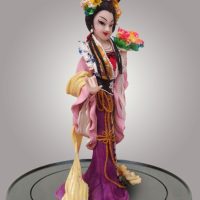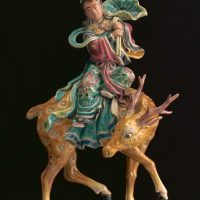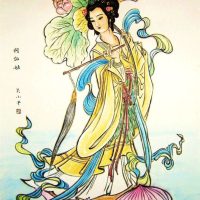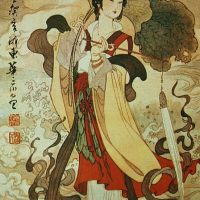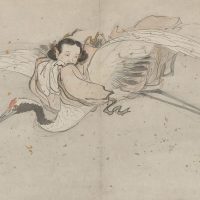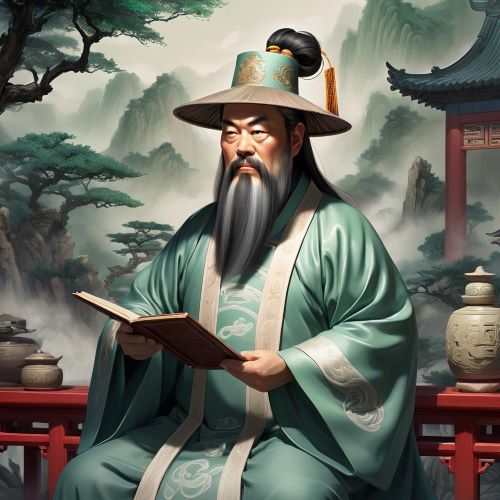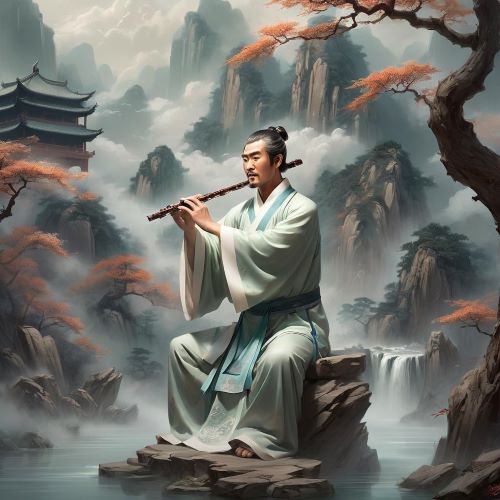He Xian Gu : The Flying Immortal
Listen
At a glance
| Description | |
|---|---|
| Origin | Chinese Mythology |
| Classification | Demigods |
| Family Members | N/A |
| Region | China |
| Associated With | Levitation, Shapeshifting |
He Xian Gu
Introduction
He Xian Gu, also recognized as Ho Hsien-ku, holds a revered place in Chinese mythology as one of the Baxian, the Eight Immortals of Daoism. Her transition from mortal to immortal has captivated hearts and minds for centuries, serving as both an inspiration and a subject of fascination. As a member of the esteemed Eight Immortals, esteemed deities within Taoist beliefs, she symbolizes the quest for immortality while embodying ideals of beauty, purity, and harmony with nature. The legends surrounding He Xian Gu, originally named He Qiong, exhibit variations in detail but maintain a consistent core narrative.
Born during the Tang Dynasty, she bore an unconventional aura from birth, characterized by six long hairs atop her head. Her journey towards immortality unfolds through a series of transformative moments: a divine dream prompting her to ingest powdered mica, a lifelong commitment to vegetarianism and chastity, and ultimately, a celestial ascension beyond the confines of mortal existence. He Xian Gu’s story resonates with themes of spiritual devotion, transcending natural limitations, and embracing a life harmonized with the rhythms of nature.
Physical Traits
He Xian Gu is commonly depicted as a strikingly beautiful woman, possessing an ethereal quality that captivates the imagination. Often portrayed carrying a lotus flower, a potent symbol of both mental and physical well-being, she embodies the ideals of health and harmony. Some artistic renditions show her gracefully riding a celestial crane, a powerful emblem of her attainment of immortality. Throughout various representations, He Xian Gu is portrayed as a youthful figure emanating an otherworldly allure. Her features, delicately framed by cascading black hair, exude a soft radiance that seems to transcend earthly bounds.
Draped in flowing robes adorned with intricate floral patterns, she reflects an intimate connection with the abundance of the natural world. The lotus flower, evoking notions of purity and spiritual enlightenment, frequently accompanies her, underscoring her journey of inner growth. Additionally, the peach, synonymous with longevity and eternal life, often plays a prominent role, either cradled in her hand or woven into her attire. In essence, He Xian Gu’s physical presence serves as a manifestation of her celestial essence, transcending the ordinary and embodying the divine.
Family
He Xian Gu entered the world during the illustrious Tang Dynasty (618-907), born to He Tai, a denizen of Guangzhou, a bustling port nestled along the Pearl River. Known by her birth name, He Qiong, her familial background, while not as prominently featured as in the tales of other Eight Immortals, occasionally emerges in certain accounts. Her father, He Tai, is depicted in some narratives as a merchant residing in either Guangdong or Hunan. While some portrayals emphasize He Xian Gu’s role as a dutiful daughter, committed to the principles of filial piety before her eventual transcendence beyond mortal confines, others weave tales of divine origin, suggesting her birth from a celestial peach tree as a symbol of divine favor and auspiciousness.
Other names
In addition to being known as He Xian Gu and He Qiong, she is also recognized by the Wade-Giles romanization of her name, “Ho Hsien-ku.” Besides the appellation He Xian Gu, which translates to “Immortal Woman He,” several other names shed light on different facets of her legendary persona. One such name is “He Qiong,” her given name, which connotes “beautiful jade,” suggesting her inner purity and grace. Another name, “Hong E Mi Nu,” translates to “Jade Maiden of Red Cliff,” pointing to her connection to a specific geographical location and underscoring her affinity with the natural world. These varied names provide diverse perspectives on He Xian Gu, enriching the tapestry of her character and allowing for nuanced interpretations.
Powers and Abilities
He Xian Gu embarked on her path to immortality after dreaming of mother-of-pearl conferring everlasting life. Upon ingesting it, she transcended the mortal realm, gaining the ethereal ability to glide effortlessly across hills. Each evening, she would return home bearing herbs gathered throughout the day. Immortalized through her unwavering dedication to Daoist practices and teachings, He Xian Gu embodies divinity. Endowed with extraordinary abilities, legends attribute to her the power of levitation, enabling her to traverse great distances effortlessly. Her mastery of herbal lore allows her to harness the healing properties of plants, rejuvenating those in need. Some tales even suggest she possesses the gift of shape-shifting, deepening her connection to the natural world. Above all, He Xian Gu embodies the essence of immortality, symbolizing liberation from the eternal cycle of birth and death.
Modern Day Influence
He Xian Gu remains a prominent figure in contemporary society, her tale serving as a poignant testament to the quest for spiritual liberation and the transformative power of selflessness. Revered as a paragon of moral purity, filial piety, and unwavering dedication to spiritual enlightenment, she continues to inspire individuals in their pursuit of harmony with the Tao, or the ‘Way’. Her likeness is frequently depicted in Taoist iconography, serving as a guiding beacon for those seeking alignment with the natural order.
He Xian Gu’s presence extends across various artistic mediums, from paintings and literature to celebratory rituals, reaffirming the enduring significance of her spiritual journey. Her image adorns ceramics, paintings, and textiles, serving as a tangible reminder of her lasting legacy and the timeless wisdom she embodies. Moreover, practitioners of traditional Chinese medicine invoke her name, honoring her mastery of herbal remedies and the healing arts.
Beyond the borders of China, He Xian Gu’s influence transcends cultural boundaries, featuring in adaptations of Chinese mythology worldwide. Her enduring presence sparks the imagination and inspires creative interpretations, underscoring her universal appeal and timeless relevance in the human quest for spiritual fulfillment.
Related Images
Frequently Asked Questions
What is lorem Ipsum?
I am text block. Click edit button to change this text. Lorem ipsum dolor sit amet, consectetur adipiscing elit. Ut elit tellus, luctus nec ullamcorper mattis, pulvinar dapibus leo.
What is lorem Ipsum?
I am text block. Click edit button to change this text. Lorem ipsum dolor sit amet, consectetur adipiscing elit. Ut elit tellus, luctus nec ullamcorper mattis, pulvinar dapibus leo.
What is lorem Ipsum?
I am text block. Click edit button to change this text. Lorem ipsum dolor sit amet, consectetur adipiscing elit. Ut elit tellus, luctus nec ullamcorper mattis, pulvinar dapibus leo.
What is lorem Ipsum?
I am text block. Click edit button to change this text. Lorem ipsum dolor sit amet, consectetur adipiscing elit. Ut elit tellus, luctus nec ullamcorper mattis, pulvinar dapibus leo.
What is lorem Ipsum?
I am text block. Click edit button to change this text. Lorem ipsum dolor sit amet, consectetur adipiscing elit. Ut elit tellus, luctus nec ullamcorper mattis, pulvinar dapibus leo.

